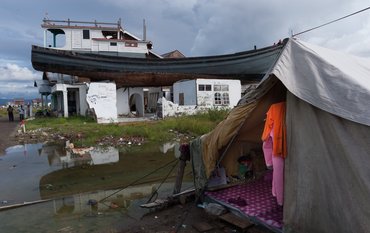A review in 11 questions and answers on the flood situation in Austria, the Czech Republic, Poland and Germany in September 2024 by experts from the Helmholtz Research Field Earth and Environment
Europe has been affected by numerous severe extreme weather and flood events in recent months, causing many deaths and extensive damage. The south-east of Spain is currently experiencing catastrophic flooding.
In September 2024, extreme, prolonged rainfall led to widespread flooding, particularly in Austria, the Czech Republic, Poland, Romania and Slovakia. In Germany, the effects were less severe than during the major flood events of winter 2023/24 and June 2024.
Here, experts from the Helmholtz Research Field Earth and Environment answer important questions about causes and consequences, forecasting, protection and adaptation options, and they place the event in the series of severe flood events of the recent past and in the context of climate change. And they give links to the respective studies and sources.
Scientists from the GFZ German Research Centre for Geosciences, the Helmholtz Centre for Environmental Research UFZ and the Karlsruhe Institute of Technology KIT are involved (in detail: see below).
1. What were the causes of the extreme flooding and what was unusual about it?
The overriding cause was a “Vb cyclone”. The term goes back to the German meteorologist Wilhelm Jacob van Bebber, who in 1891 published a paper on the preferred tracks cyclones are taking. He numbered these tracks with Roman numerals. Today we know that his cyclone track Vb is repeatedly favored by low-pressure areas.
Meteorologically, this low-pressure system develops over northern Italy, often also over the Gulf of Genoa, when a high-altitude trough with cold, high-altitude air can penetrate over the Alps into the northern or central Mediterranean region. The high-altitude trough then usually pushes this low-pressure system northeastwards across the Alps towards Central and Eastern Europe and the Baltic states.
The fact that the depression taps into moist Mediterranean air from the Adriatic, among other places, and leads it east around the Alpine barrier is very effective to generate high precipitation. Over Central and Eastern Europe, this often manifests itself in a southeast to east flow in layers above 2-3 km from the ground, as this warm, moist Mediterranean air glides on a cold north to northwest flow close to the ground, originating from the North and Baltic Seas.
The intense precipitation is caused by the Mediterranean air gliding onto the cold north-westerly current and the north jam at east-west mountain barriers such as the Alps, the Ore Mountains, the Giant Mountains, the Jeseníky Mountains or the High Tatras. Situations become particularly critical when the Vb low and its fronts remain stationary for longer time. This interaction was responsible for the Elbe flood in 2002 and the highest 24-hour precipitation in Germany to date of 312 mm in the Erzgebirge in August 2002 (Ulbrich et al., 2003). The Oder flood of 1997 and the June flood of 2024 in Bavaria and Baden-Württemberg also occurred in connection with Vb situations.
Vb cyclones can occur all year round, but are more frequent in spring and fall. A heated Mediterranean Sea in summer and fall provides a particularly high level of moisture for precipitation.
What was unusual about the event in September 2024 was the stationarity and thus duration of the weather conditions. In addition, record water temperatures were recorded in the Mediterranean. This contributed to the low-pressure system being able to tap into and transport large quantities of moist air masses. The heatwave that hit the Mediterranean region in July 2024 would have been practically impossible without man-made climate change, according to studies by the scientific consortium “World Weather Attribution”. It also contributed to the record water temperatures.
Publications and sources:
Ulbrich, U., T. Brücher, A. H. Fink, A. Krüger and G.C. Leckebusch, J. Pinto, 2003: The central European floods in August 2002. Part II: Synoptic causes and considerations with respect to climate change. Weather, 58 (10), 434-442,
https://doi.org/10.1256/wea.61.03B
2. What are the differences to the flood in June 2024 or the winter flood 2023/24?
Various meteorological factors as well as combinations of precipitation amounts and intensities, the water absorption capacity of the soil and the topography of the catchment area can lead to flood events that can differ significantly in their spatial extent as well as in the magnitude, duration and dynamics of the flooding (Merz, Tarasova & Basso, 2020).
The winter flood of 2023/24 was not caused by a Vb low, but by repeated Atlantic low-pressure systems in a westerly direction. In this respect, it was a typical winter flood as in January 1995 on the Rhine without the snowmelt components (Fink et al., 1996). The flood in June 2024, on the other hand, was also due to a Vb situation. Here, however, the path of the low-pressure system was further west than in September 2024.
The amount of precipitation during the September flood was significantly higher than in June 2024 and the winter flood of 2023/2024. The largest precipitation amounts hit Austria, the Czech Republic, Poland, Romania and Slovakia. This means that comparatively small areas in Germany were directly affected by flooding. There was no large-scale inundation along the Oder, for example.
In addition to precipitation dynamics, soil moisture is also decisive for the flood discharges (Merz, Tarasova & Basso, 2020). In the fall of 2023, the soils were barely able to absorb any additional precipitation. The combination of precipitation and snowmelt around Christmas 2023 then led to considerable discharge volumes in many German rivers and the resulting flood situation. In contrast to the flood situation in southern Germany in June 2024 and the September flood, however, the intensity of precipitation at the turn of the year 2023/24 was lower, so that no extreme flood discharges occurred in numerous rivers and flood protection was able to prevent extreme damage.
In September 2024, the soils in the Elbe catchment were very dry and were therefore able to act as a flood retention area. The prolonged rainfall meant that the rainwater was also able to infiltrate into the ground. Between September 8 and 23, the highest precipitation fell in Bavaria and especially Berchtesgaden, but more than 100 mm also fell over large areas in Saxony (Fig. 1 left). Here, the largest proportion, up to 80% of the precipitation, infiltrated into the ground, so that the tributaries to the Elbe and Oder rivers in Germany did not significantly exacerbate the flood situation (Fig. 1 right).
Publications and sources:
Fink, A., U. Ulbrich, und H. Engel, 1996: Aspekte des Januar-Hochwassers 1995 in Deutschland. Wetter, 51 (2), 34-39
Merz, R., Tarasova, L., und Basso, S. (2020). Das Hochwasser-Kochbuch: Zutaten und regionale Geschmacksrichtungen von Hochwassern in Deutschland. ERL, 15(11), 114024.
https://doi.org/10.1088/1748-9326/abb9dd
3. Have such extreme events occurred more frequently in recent years or decades?
(Note: See also question/answer Flood June 2024)
A study by GeoSphere Austria - Federal Institute for Geology, Geophysics, Climatology and Meteorology in Austria shows that Vb situations do not occur more frequently, but are becoming more intense.
In Central Europe and Northwestern Europe, statistically significant increases in flood discharges have been observed in recent decades, i.e. flood levels have increased over large areas (Blöschl et al., 2019).
We also see in the observation data that extreme precipitation is increasing. One study, for example, analyzed the number of record precipitation events from thousands of climate stations. It showed that in recent years, the number of record precipitation events, i.e. precipitation that has not yet been measured at these stations, is 30 percent higher worldwide than would be expected in a world without climate change (Robinson et al., 2021).
Publications and sources:
Blöschl, G., Hall, J., Viglione, A., Perdigão, R. A. P., Parajka, J., Merz, B., . . . Živković, N. (2019). Der Klimawandel führt zu mehr und weniger Hochwasser in europäischen Flüssen. Nature, 573(7772), 108-111. https://doi.org/10.1038/s41586-019-1495-6
Robinson, A., Lehmann, J., Barriopedro, D., Rahmstorf, S., & Coumou, D. (2021). Zunehmende Hitze- und Niederschlagsextreme jetzt weit außerhalb des historischen Klimas. Npj Climate and Atmospheric Science, 4(1), 3-6. https://doi.org/10.1038/s41612-021-00202-w
https://www.zamg.ac.at/cms/de/klima/news/deutlich-mehr-regen-als-bei-frueheren-extremereignissen
4. What role does climate change play in this? Should we expect more frequent or even worse events in the future?
Climate change is altering the probabilities of extreme weather events and thus of flooding. However, these changes vary regionally and for different types of floods (Kemter et al., 2020; Tarasova et al., 2023). There is a direct link between climate change and flooding in the case of local flooding caused by short and heavy rainfall, such as thunderstorms. Global warming is increasing localized heavy precipitation in particular, and we are seeing a trend towards more convective weather conditions in Germany.
The effects of climate change on river flooding are less clear. Here it depends on the interaction of heavy precipitation and water storage in the catchment area (e.g., in the soil and groundwater). In mountainous regions, the effects of climate change on snowfall and snowmelt also play a role. Overall, however, we will find ourselves in a situation more often than before in which the existing protective measures are overloaded.
In this respect, in addition to technical protection measures such as dykes and retention basins, better preparation for such extreme events is needed. One sensible measure is to improve warning systems and the population's response to extreme situations (Najafi et al., 2024). Only if people are informed and know what to do can they react well in an emergency situation (Kreibich et al., 2021).
Another measure is to subject our critical infrastructure (e.g. energy and water supply, hospitals) and our sensitive infrastructure (e.g. care homes) to stress tests, identify critical points and ensure that damage and outages can be largely reduced in such cases.
In a recent study by the scientific consortium “World Weather Attribution”, the connection between the 4-day precipitation amounts in the September 2024 event and man-made climate change was examined. The results show that the probability of such events has doubled in the current 1.3°C warmer world compared to pre-industrial times. According to model-based analyses, man-made climate change has also caused a 7 percent increase in precipitation intensity. The record temperatures of the Mediterranean Sea play a role here. These increase evaporation from the water surface and the warm air masses can absorb and transport more moisture. If temperatures continue to rise in the future, we must expect a further increase in precipitation intensity.
Publications and sources:
Husain Najafi, Pallav Kumar Shrestha, Oldrich Rakovec, Heiko Apel, Sergiy Vorogushyn, Rohini Kumar, Stephan Thober, Bruno Merz, and Luis Samaniego: High-Resolution Impact-based Early Warning System for Riverine Flooding. Nature Communications,
https://doi.org/10.1038/s41467-024-48065-y
Kreibich, H., Hudson, P., & Merz, B. (2021). Knowing What to Do Substantially Improves the Effectiveness of Flood Early Warning. Bulletin of the American Meteorological Society, 102(7), E1450-E1463.
https://doi.org/10.1175/BAMS-D-20-0262.1
Kemter, M., Merz, B., Marwan, N., Vorogushyn, S., & Blöschl, G. (2020). Joint Trends in Flood Magnitudes and Spatial Extents Across Europe. Geophysical Research Letters, 47(7), e2020GL087464.
https://doi.org/10.1029/2020GL087464
Tarasova, L., Lun, D., Merz, R., Blöschl, G., Basso, S., Bertola, M., Miniussi, A., Rakovec, O., Samaniego, L., Thober, S., Kumar, R. (2023): Verschiebungen in der Hochwasserentstehung verschärfen regionale Hochwasseranomalien in Europa, Commun. Earth Environ. 4,
https://doi.org/10.1038/s43247-023-00714-8
5. Is the term “flood of the century” still appropriate when such severe events occur more frequently?
From a hydrological point of view, we don't talk about floods of the century, but about 100-year floods. This term expresses the fact that we have to reckon with such an event at a particular location on average once every 100 years. However, this does not mean that such an event occurs every 100 years, as extreme floods do not occur regularly. It means that we have a 1% probability of such an event occurring in a given year. Several such events can also occur in a few years.
Another aspect is that the term 100-year flood assumes a constant environment. However, climate change and interventions in our landscapes and rivers are changing the probability of a particular flood occurring. In a “rapidly” changing climate, this statistical term thus loses its basis. What was a 100-year flood yesterday may be a 20-year event today, for example.
For these reasons, but also for psychological reasons, the term “flood of the century” is problematic. It can easily be interpreted as the worst flood that can happen in a century. And if such a flood of the century has occurred, it sounds as if the next comparably severe event can only happen far in the future. But neither is the case. Even if it is not as easy for citizens to understand as the term “flood of the century”, it would probably be better to operate with probabilities. And to communicate that these probabilities can change, especially due to climate change.
6. How well can such flood extremes be predicted regionally?
This depends above all on how good the precipitation forecasts are. During the floods in September 2024, various forecasting models, such as those of the German or European weather services, indicated the enormous amounts of precipitation several days in advance, even if there were still uncertainties regarding the spatial location and amount at that time. The flood forecasting centers transform the predicted or measured precipitation into discharges in the various rivers using hydrological and hydrodynamic models. In contrast to the discharge forecasts for small basins, the forecasts of discharges and water levels for larger rivers are usually very good. One advantage of larger rivers is that the flood wave remains in the river system for a longer period of time. These processes can be better captured and simulated with less uncertainty than the atmospheric processes and the processes in the catchment areas.
Problems with forecasting on larger rivers arise above all when large floods occur, e.g. due to dyke breaches. Dyke breaches cannot be predicted, but can significantly change the flood wave by reducing the peak of the flood wave downstream the dyke breach. One challenge during such cross-border events is the cooperation between several countries or federal states. Here, the cross-border flood events of the past decades have significantly improved coordination, for example for the transfer of data in real time.
7. How has flood protection progressed in Germany? How much has been developed and improved in recent years?
Technical flood protection measures such as the construction of dykes, dams and retention areas date back several decades. Following the 2013 floods in the Elbe and Danube regions, which were also triggered by a Vb cyclone like the September floods, the Conference of Environment Ministers of German Federal States decided to draw up and implement the National Flood Protection Program (NHWSP) in order to further strengthen flood protection. The program comprises a total of 242 individual measures on the Danube, Elbe, Rhine, Oder and Weser, including 33 dyke relocations and 61 controlled flood retention areas. The estimated investment volume required is 6.7 billion euro.
The effectiveness of the planned measures was examined and positively assessed in a model-based study by the Federal Institute of Hydrology on behalf of the Federal Environment Agency.
However, only 9 measures had been implemented by November 2022. Most of the measures are still in the design, planning, approval or construction phase. In order to speed up the planning approval and planning authorization procedures, among other things, the Federal Ministry for the Environment has announced a new flood protection law. Such a law would be an important step towards staying ahead in the race against climate change.
At the same time, standardized surveys in flood-affected areas show that the proportion of households that take and implement precautions against flooding, heavy rainfall and storm surges has increased in recent years. The more frequently a household is affected by flooding, the more likely it is to take precautions (Köhler et al. 2023). This includes both behavioral precautions and taking out insurance as well as structural precautions.
Publications and sources:
https://www.umweltbundesamt.de/publikationen/untersuchungen-zur-ermittlung-der-wirkungen-von
LAWA (2023): 10 years of the National Flood Protection Program (NHWSP). Federal/State Working Group on Water (LAWA). https://www.lawa.de/documents/230531-broschuere-10-jahre-nhwsp-barr_1685951529.pdf
https://www.bmuv.de/fileadmin/Daten_BMU/Download_PDF/Klimaanpassung/hochwasserschutz_bf.pdf
Köhler, L., Masson, T., Köhler, S., Kuhlicke, C. (2023): Better prepared but less resilient: the paradoxical impact of frequent flood experience on adaptive behavior and resilience. Nat. Hazards Earth Syst. Sci. 23 (8), 2787 - 2806 10.5194/nhess-23-2787-2023 https://nhess.copernicus.org/articles/23/2787/2023/
8. What needs to be improved in terms of protection and prevention measures?
Our research results show that floods that affect several catchment areas and river sections at the same time are increasing (Kemter et al., 2020, Fang et al., 2024). This increasing extent is due to the change in flood processes, which can be seen as consistent with current climate change. The aforementioned stationarity or duration of the precipitation event played a particular role in the September 2024 flood. Such events pose major challenges for flood protection. Cross-border cooperation is becoming increasingly important – both in the timely exchange of data, the communication of forecasts and the management of flood situations as well as for coordinated flood protection and prevention measures. For example, it will be necessary to strengthen operational capacities, technical equipment and logistics across the board in order to be able to deal with the consequences of flooding in several municipalities and communities within a short period of time.
Publications and sources:
Fang, B., Bevacqua, E., Rakovec, O., und Zscheischler, J. (2024): Eine Zunahme der räumlichen Ausdehnung von Hochwasser in Europa in den letzten 70 Jahren, EGUsphere [Preprint],
https://doi.org/10.5194/egusphere-2023-2890
Fünf Prinzipien für klimasichere Kommunen und Städte (2021) https://www.ufz.de/index.php?de=40374
Kemter, M., Merz, B., Marwan, N., Vorogushyn, S., & Blöschl, G. (2020). Joint Trends in Flood Magnitudes and Spatial Extents Across Europe. Geophysical Research Letters, 47(7), e2020GL087464. https://doi.org/10.1029/2020GL087464
9. Is compulsory insurance for natural hazards coming?
The issue of compulsory insurance for natural hazards such as flooding and inundation has been discussed for many years, especially after severe flooding events such as the Elbe flood in 2002 or the Ahr flood and adjacent regions in 2021. In both cases, the federal government provided billions in aid from taxpayers' money to those affected. According to the German Insurance Association (GDV), around 50% of all private homes in Germany are insured against damage caused by natural hazards, although the insurance penetration rates vary greatly depending on the federal state (Baden-Württemberg: 94%; Bremen 31%).
Although the federal states have been calling for compulsory insurance for a long time, the federal and state governments were unable to agree on compulsory insurance for natural hazards at the Minister Presidents' Conference in Berlin on June 20, 2024. Both the GDV and Federal Minister of Justice Marco Buschmann reject this. The federal government's proposal to introduce a mandatory offer for insurers did not go far enough for the federal states.
From today's perspective, it is impossible to say whether compulsory insurance for damage caused by natural hazards is finally off the table. However, it is clear that severe flood events will occur more frequently and more intensively in the future due to climate change. It can therefore be assumed that the issue of compulsory insurance will be on the agenda at the latest after the next severe flood in Germany.
10. What other long-term consequences does the flood have? What role do pollutants play? How can we react to them?
The introduction of faecal germs into flood water – e.g. from small sewage treatment plants – can result in regional problems lasting several weeks to months. In such cases, germ-contaminated drinking water used as food must be boiled and / or chlorinated by the drinking water works. A contamination of flooded public playgrounds with germs or pollutants cannot be ruled out; in this case, use is generally prohibited by the authorities until these areas are cleared again by the local authorities.
Mold infestation of flooded objects, which can also persist over a longer period of time, can have harmful effects on health. If necessary, a protective mask should be worn; skin contact should be avoided (1).
Long-term, local damage caused by pollutants is to be expected from leaked heating oil from heating oil tanks / oil burners. Preventive measures are usually published on the Internet by the responsible ministries and / or state offices.
The extent to which other pollutants have leaked locally from vehicles flooded in underpasses is not known. The wading capacity of cars, SUVs and vans is often overestimated. Water depths of more than 20 cm are hardly passable with an ordinary car.
Underestimated are also flooded or submerged garden sheds or cellars, where pesticides, paints and solvents are often stored. If containers come into contact with water, local pollution cannot be ruled out.
Hygiene rules are a key prevention and safety measure in connection with flood-related pollutant emissions and inputs. For example, the Robert Koch Institute advises: “to protect yourself from contact with water that may be contaminated with pathogens when cleaning houses and apartments after flooding by wearing rubber boots, waterproof gloves and water-repellent clothing and to wash your hands carefully with hygienically safe water before preparing and eating food and smoking.” (5) These measures also protect against contact with other pollutants.
Other possible flood-related pollutant inputs from mining, agriculture and contaminated sites from industry and commerce are often very regional and so specific that no generally applicable statements can be made. On the one hand, owners are obliged to report such pollutant discharges. On the other hand, state authorities are aware of possible sources of pollution. In the event of suspected cases, necessary investigations are required following a flood event in accordance with the Federal Soil Protection and Contaminated Sites Ordinance, from which remediation measures can be derived if necessary.
Severe floods such as the one in 2021 are associated with enormous psychosocial stress, which also has a long-term effect. A household survey conducted one year after the 2021 floods showed that almost 30% of the households surveyed showed signs of post-traumatic stress disorder (Zenker et al. 2024). Furthermore, surveys show that households that are particularly frequently affected by floods and heavy rainfall often feel powerless, even though they have often implemented comprehensive precautionary measures (Köhler et al. 2023).
Publications and sources:
(1) Frequently asked questions about mold infestation
https://www.umweltbundesamt.de/themen/gesundheit/umwelteinfluesse-auf-den-menschen/schimmel/haeufige-fragen-bei-schimmelbefall#haufige-fragen-bei-schimmelbefall, retrieved 13.06.2024
(2) Floods and heating oil consumer systems
https://www.saarland.de/mukmav/DE/portale/wasser/informationen/heizoelverbraucheranlagen/heizoelverbr-hochwasser, retrieved 13.06.2024
(3) Safe heating oil storage in the flood zone, retrieved 13.06.2024
(4) Floods pose health risks.
https://www.swr.de/wissen/hochwasser-in-sueddeutschland-gesundheit-risiko-100.html, retrieved 13.06.2024
(5) Infection risks in floodplains in Germany. https://www.rki.de/DE/Content/InfAZ/U/Ueberschwemmung/Infektionsrisiken.html, retrieved 13.06.2024
Zenker, M.-L., Bubeck, P., Thieken, A. (2024) Always on my mind: indication of post-traumatic stress disorder among those affected by the 2021 flood event in the Ahr valley, Germany. NHESS,
https://doi.org/10.5194/nhess-24-2837-2024
Köhler, L., Masson, T., Köhler, S., Kuhlicke, C. (2023): Better prepared but less resilient: the paradoxical impact of frequent flood experience on adaptive behavior and resilience. Nat. Hazards Earth Syst. Sci. 23 (8), 2787 - 2806 http://doi.org/10.5194/nhess-23-2787-2023
11. Should the interactions of extremes such as heavy rain/flooding, heatwaves and drought be considered in adaptation measures?
It is not only heavy rainfall and flooding events that are increasing, but also drought and heatwaves. Water that should be quickly removed from the city or landscape during a heavy rain or flood event is urgently needed for cooling during the next heatwave or for irrigation during a prolonged drought. Integrated water management concepts must therefore be developed and implemented, such as sponge cities and landscapes. These concepts should strengthen the climate resilience of the landscape water balance. Better infiltration possibilities of water in the landscape, retention basins and reservoirs are adaptation options for changing heavy rainfall as well as heat and drought risks. The successful implementation of integrated concepts and the realization of synergies in individual adaptation measures require inter- and transdisciplinary approaches that have not yet been comprehensively researched and derived. A literature review on flood and drought interactions provides examples of how flood or drought risk management measures can have (unintended) positive or negative effects on the risk of the other hazard and how flood or drought measures can be negatively affected by the other hazard (Ward et al., 2020). For example, there are some dykes and dams that have failed due to drought in flood situations. However, if dykes and dams are irrigated during dry periods, less water is available for other purposes.
Publications and sources:
Ward, P. J., de Ruiter, M. C., Mård, J., Schröter, K., Van Loon, A., Veldkamp, T., von Uexkull, N., Wanders, N., AghaKouchak, A., Arnbjerg-Nielsen, K., Capewell, L., Carmen Llasat, M., Day, R., Dewals, B., Di Baldassarre, G., Huning, L. S., Kreibich, H., Mazzoleni, M., Savelli, E., Teutschbein, C., van den Berg, H., van der Heijden, A., Vincken, J. M., Waterloo, M. J., Wens, M. (2020): The need to integrate flood and drought disaster risk reduction strategies. - Water Security, 11, 100070.
https://doi.org/10.1016/j.wasec.2020.100070
Further information:
GFZ FAQ on the floods in January 2024:
https://www.gfz-potsdam.de/presse/meldungen/detailansicht/fragen-und-antworten-zur-aktuellen-hochwasserlage-in-deutschland
The GFZ and UFZ FAQ on the floods in June 2024:
https://www.gfz-potsdam.de/presse/meldungen/detailansicht/anlaesslich-der-hochwasserlage-in-sueddeutschland
UFZ-Website Im Fokus „Fragen und Antworten zu Wasserextremereignissen in Deutschland“:
https://www.ufz.de/index.php?de=51222
The experts:
GFZ German Research Centre for Geosciences
https://www.gfz-potsdam.de/
Prof. Dr. Bruno Merz
Dr. Sergiy Vorogushyn
Priv. Doz. Dr. Heidi Kreibich
M.Sc. Elena Macdonald
Helmholtz Centre for Environmental Research (UFZ)
https://www.ufz.de
Prof. Dr. Dietrich Borchardt
Prof. Dr. Ralf Merz
Prof. Dr. Sabine Attinger
Dr. Andreas Marx
Dr. Larisa Tarasova
Dr. Wolf von Tümpling
Prof. Dr. Reimund Schwarze
Karlsruher Institute of Technology (KIT) & Center for Disaster Management and Risk Reduction Technology (CEDIM)
https://www.kit.edu
https://www.cedim.kit.edu
Prof. Dr. Andreas Fink
Prof. Dr. Harald Kunstmann
Media Contact
GFZ / Kommunikation & Medien / presse@gfz-potsdam.de
UFZ / Presse- und Öffentlichkeitsarbeit / presse@ufz.de
KIT / Medien/Public Relations / presse@kit.edu









![[Translate to English:] Fire in a forest, smoke rising, aerial view from above](/fileadmin/_processed_/8/3/csm_2025_01_06_AdobeStock_415831729_5a0e6d50d3.jpeg)









![[Translate to English:] [Translate to English:] Abror Gafurov von dem Schriftzug "Welcome to Azerbaijan" und den UN und COP Logos](/fileadmin/_processed_/2/5/csm_2024_11_Baku_COP29_Abror_Gafurov_1042faec82.jpeg)


![[Translate to English:] Martin Herold standing in front of the library on the Telegrafenberg](/fileadmin/_processed_/c/d/csm_Martin_Herold_d385ee4dd9.jpeg)
![[Translate to English:] Many people are listening to a presentation in the GFZ lecture hall.](/fileadmin/_processed_/c/a/csm_1_Bild1_hell_b9c0e9f5ed.jpeg)





![[Translate to English:] Both scientists sitting on stools in front of a wall of books in the Telegrafenberg library](/fileadmin/_processed_/6/6/csm_Buiter_Castell_DORA_4_e87cb1ea18.jpeg)
![[Translate to English:] Gruppenbild mit 4 Personen](/fileadmin/_processed_/8/d/csm_20241017_GFZ-Emmerman-Medal-005_web_reinhardtundsommer_21a414fa4a.jpeg)






![[Translate to English:] Ice landscape with five red tents](/fileadmin/_processed_/8/9/csm_Zeltlager_auf_dem_Eis_Urheberin_Jenine_McCutcheon_5ced2d523b.jpeg)
